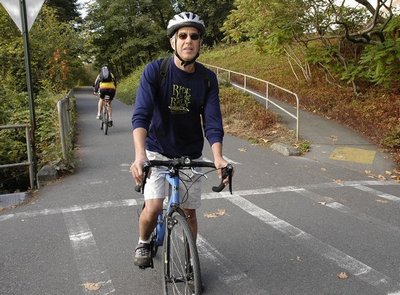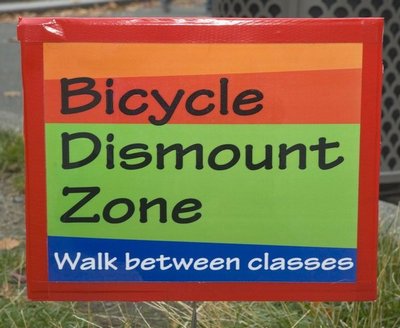October 13, 2005
Campus bike safety in the spotlight
UPDATE (Oct. 3, 2023): Hall Health no longer provides bike safety equipment. The ASUW Bike Shop sells gear, while the U Bike program provides equipment for rent.
Have you noticed the colorful signs planted strategically around campus these days that say: “Dismount zone”? They’re also signs of a new awareness of bicycle safety at the UW.
And the signs mean just what they say: In the central part of campus, where the HUB is, bicycle riders are expected to dismount and walk their bikes in between classes when pedestrian traffic is at its peak.
It’s always been the case, but now the UW Transportation Services Department is reminding people of that policy as part of a new, campuswide campaign to increase awareness of both the benefits and dangers of bike riding in such a busy area.
Or maybe you haven’t seen the signs. “Virtually all the bicyclists we spoke to were unaware of the dismount zone,” said Elena Fox, public information specialist for the Transportation Dept. She added, “It is not something we have focused on recently in our bicycle materials. This new safety awareness campaign is changing that.”
On Sept. 21, a group called the Grounds Improvement Advisory Committee met to discuss, among other things, bicycle and pedestrian safety on the paths and concourses of the UW campus.
Prompted by news of recent bike/pedestrian accidents on campus, the committee took a number of actions to help make October a month for heightened awareness of bicycle safety rules.
The committee’s actions included:
- Installation of temporary signs showing dismount zones, to be followed by more permanent signs.
- Expansion and improvement of information about bicycle safety and policies on the U-PASS Web site.
- Attaching a flier outlining campus bike safety policies to every bicycle offered in the annual bike auction and promotion of bike safety through campus organizations.
- Distribution of bike safety materials with sales of bike helmets and lights at Hall Health.
The committee also decided to identify dangerous spots for bike-pedestrian traffic on campus and seek ways to lessen the danger, and to develop a bicycle registration program that reaches out to students, faculty and staff, encouraging them to register their bikes with University Police. (Those who register during October will be entered into a drawing for new bike lights.)
But perhaps as important as any other action, the grounds committee also voted to review bicycle regulations in Western Washington with an eye on updating policies here at the UW.
The campaign of awareness and attention to bike safety does not mean the Transportation Services Dept. takes a dim view of campus and commuter biking: quite the contrary, in fact, said Paul Roybal, office manager — and a longtime daily bike commuter himself. The rules help both bike riders and pedestrians.
“One of our main objectives is to get more bicycles out there,” Roybal said. “We want to make sure people aren’t afraid to bicycle, make sure there are not a lot of impediments to overcome. We think of it as a good thing — it reduces congestion — and want to encourage that as much as possible.”
The Transportation Office also plans to convene a campus task force to review Washington Administrative Code and recommend changes to clarify regulations and penalties. (There are penalties for improper bike riding at the UW; they’re just not used much.) That task force will have representatives among the student and staff bicyclists, University Police and the administration.
One of the campus bike/pedestrian accidents that sparked the policy review was that of Carol Thomas, professor of history and chair of European studies, who was seriously injured on Aug. 3 when a campus bicyclist ran into her outside Suzzallo Library. Thomas praised the intent of the committee for giving a serious issue the attention she says it needs.
“I am pleased that some action has been taken, because the problem — caused by a few people, not everybody — has become a very serious problem, as I found out at first-hand.”
Thomas, who attended the Grounds Improvement Advisory Committee meeting and said she is interested in serving on the task force, too, applauded the tone of the discussion and breadth of its interest on campus. “I like that involvement, and I like their seriousness.”
And what about skateboards?
Peter Dewey, assistant director of Transportation Services, said the department recognizes there are safety issues with skateboards, too, and that he expects there will be evaluation of skateboard use as the bicycle policies are reviewed.
To learn more:
UW campus bicycle policies: http://www.washington.edu/upass/getting_here/biking.html).
Get involved:
If you’re interested in being considered for the task force to review bike safety policies and suggest changes and clarifications, or if you have information about a dangerous location or situation on campus for bicyclists and pedestrians, e-mail: upass@u.washington.edu.
Bike safety tips:
From the Washington State Dept. of Transportation:
- Obey all traffic, signs and lane markings and never ride against traffic.
- Don’t pass on the right.
- Scan the road behind you. Learn to look back over your shoulder without losing your balance or swerving.
- Keep both hands ready to brake, and allow extra distance for breaking in the rain.
- Wear a helmet and never ride wearing headphones. Dress in layers for comfort and in bright colors for visibility, and use lights at night.
- Make eye contact with drivers — assume they don’t see you until you are sure they do.
UW bike safety FAQ:
Q: Can I get a speeding ticket on my bike?
A: Yes. The speed limit on most campus roadways is 20 mph. Any negligent riding is subject to a $25 citation.
Q: Who has the right-of-way, a pedestrian or a bicyclist?
A: The pedestrian. The law requires cyclists to yield to a pedestrian giving audible warning of your presence. Typically, bicyclists should keep to the right and pass on the left.
Q: Can I receive a citation for riding in a dismount zone?
A: Yes. The HUB lawn and environs are a dismount zone, which means that bikes are to be walked during class breaks. Violators can be issued a $10 citation.
– Peter Kelley




